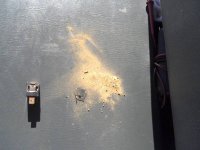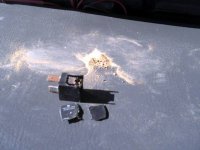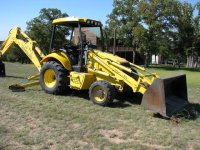jinman
Rest in Peace
- Joined
- Feb 23, 2001
- Messages
- 21,008
- Location
- Texas - Wise County - Sunset
- Tractor
- NHTC45D, NH LB75B, Ford Jubilee
. . . or so it would seem.
I just bought a used New Holland LB75B TLB. My dealer was excellent and promised me that for his asking price, he would make the tractor work ready. He changed all the fluids and filters and replaced a front wheel final drive seal and rear axle seal plus he cleaned the tractor up spotless before delivery. All went well for the first week except an intermittent start failure and finally a leaking outlet manifold on the injector pump. The dealer dutifully came and picked up the tractor, repaired the leaking injector pump and replaced the main transmission shuttle switch on the steering column since he said that was the source of the starting problem.
After a week in the shop, the tractor was returned and I was thrilled to have it working so well, until my starting problem came back. Because I didn't want to be without my tractor for a week and I pride myself in my electrical troubleshooting abilties, I decided I would troubleshoot the problem myself. Since it's an intermittent problem, it became quite a challenge. When the starter would fail, the symptom was that I would turn the key to start and nothing would happen. Sometimes if I held the key at start for a couple of seconds, the starter would engage and work. Most times, by the time I got the cover off the relay access panel and my meter attached to read power, the starter would suddenly work and continue to work over and over. The embarrassing thing was it would fail almost anytime I went to show somebody my tractor. There's nothing like showing someone your new tractor and it won't start.
Well, last week, it failed completely. Even after about a dozen attempts at turning the key to start, there was no response from the starter. I was able to troubleshoot the whole circuit and found the problem was the Starting Relay, a 12 VDC, 70 Amp relay that energizes the starter solenoid. The relay is tucked away behind the starter, mounted on the firewall behind the engine with the main 80 amp fuse. Why NH chose this spot is beyond me. It's dark, hard to access, and not a place you want to be sticking your hands when the engine is hot. Anyway, I pulled the relay and jumpered power to its coil while checking continuity to the main contacts. NOTHIN'! The relay coil had continuity, but the main contacts were not completing the start circuit. I immediately figured burned contacts were probably carbonized and not making contact. To make sure the tractor would start, I jumpered the starter with a hot wire and it worked perfectly. There is nothing wrong with the starter or solenoid.
It's dark, hard to access, and not a place you want to be sticking your hands when the engine is hot. Anyway, I pulled the relay and jumpered power to its coil while checking continuity to the main contacts. NOTHIN'! The relay coil had continuity, but the main contacts were not completing the start circuit. I immediately figured burned contacts were probably carbonized and not making contact. To make sure the tractor would start, I jumpered the starter with a hot wire and it worked perfectly. There is nothing wrong with the starter or solenoid.
I checked NH's price on the start relay and it was something like $52. I thought that seemed like a very expensive price, so I looked at Grainger and they had the relay for $8.95 plus shipping. Even with shipping, it's less than $20, so I purchased the relay and decided to jump start the tractor until it gets here.
Yesterday, I looked at the relay and it had a nick in one corner on the top that went all the way through the plastic. I looked closely and there was a hole that went all the way into the interior of the relay. I decided to cut off the top plastic cover and inspect the relay and contacts. The photos below show what I found (sorry they are cellphone quality). The darn relay was full of fine dust/sand. The quantity just blew me away. I think in the 40 years of working in electricity and electronics, this is the strangest thing I have ever seen. I found insects and animals in electric circuits, but I've never found a sealed relay with a tiny hole that was packed full of sand. I could not believe my eyes. There must have been close to a teaspoon full of sand in the relay.
After removing the sand, I put the relay back into the socket and it still would not work, but the contacts got hot. That told me there was contact resistance and I removed the relay and cleaned the contacts. I returned the relay to the circuit and it works perfectly. My tractor starts instantly. I'll leave it this way until the new relay arrives from Grainger.
I'm still completely baffled as to how this relay got full of sand, but I think the problem may have been the thorough pressure washing the tractor got at the dealer before delivery. I was there when they were washing the tractor and they had the engine side panels off and were cleaning all inside the engine compartment. What do you bet the pressure washing sent mud and sand down the firewall and into this relay? It's gotta be that. Very weird. How this relay ever worked when it was packed full of sand is beyond my comprehension.
How this relay ever worked when it was packed full of sand is beyond my comprehension.
I just bought a used New Holland LB75B TLB. My dealer was excellent and promised me that for his asking price, he would make the tractor work ready. He changed all the fluids and filters and replaced a front wheel final drive seal and rear axle seal plus he cleaned the tractor up spotless before delivery. All went well for the first week except an intermittent start failure and finally a leaking outlet manifold on the injector pump. The dealer dutifully came and picked up the tractor, repaired the leaking injector pump and replaced the main transmission shuttle switch on the steering column since he said that was the source of the starting problem.
After a week in the shop, the tractor was returned and I was thrilled to have it working so well, until my starting problem came back. Because I didn't want to be without my tractor for a week and I pride myself in my electrical troubleshooting abilties, I decided I would troubleshoot the problem myself. Since it's an intermittent problem, it became quite a challenge. When the starter would fail, the symptom was that I would turn the key to start and nothing would happen. Sometimes if I held the key at start for a couple of seconds, the starter would engage and work. Most times, by the time I got the cover off the relay access panel and my meter attached to read power, the starter would suddenly work and continue to work over and over. The embarrassing thing was it would fail almost anytime I went to show somebody my tractor. There's nothing like showing someone your new tractor and it won't start.
Well, last week, it failed completely. Even after about a dozen attempts at turning the key to start, there was no response from the starter. I was able to troubleshoot the whole circuit and found the problem was the Starting Relay, a 12 VDC, 70 Amp relay that energizes the starter solenoid. The relay is tucked away behind the starter, mounted on the firewall behind the engine with the main 80 amp fuse. Why NH chose this spot is beyond me.
I checked NH's price on the start relay and it was something like $52. I thought that seemed like a very expensive price, so I looked at Grainger and they had the relay for $8.95 plus shipping. Even with shipping, it's less than $20, so I purchased the relay and decided to jump start the tractor until it gets here.
Yesterday, I looked at the relay and it had a nick in one corner on the top that went all the way through the plastic. I looked closely and there was a hole that went all the way into the interior of the relay. I decided to cut off the top plastic cover and inspect the relay and contacts. The photos below show what I found (sorry they are cellphone quality). The darn relay was full of fine dust/sand. The quantity just blew me away. I think in the 40 years of working in electricity and electronics, this is the strangest thing I have ever seen. I found insects and animals in electric circuits, but I've never found a sealed relay with a tiny hole that was packed full of sand. I could not believe my eyes. There must have been close to a teaspoon full of sand in the relay.
After removing the sand, I put the relay back into the socket and it still would not work, but the contacts got hot. That told me there was contact resistance and I removed the relay and cleaned the contacts. I returned the relay to the circuit and it works perfectly. My tractor starts instantly. I'll leave it this way until the new relay arrives from Grainger.
I'm still completely baffled as to how this relay got full of sand, but I think the problem may have been the thorough pressure washing the tractor got at the dealer before delivery. I was there when they were washing the tractor and they had the engine side panels off and were cleaning all inside the engine compartment. What do you bet the pressure washing sent mud and sand down the firewall and into this relay? It's gotta be that. Very weird.


